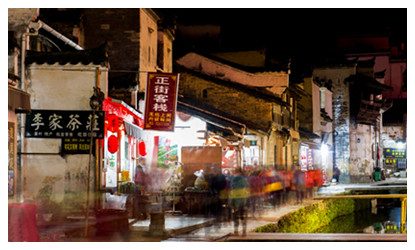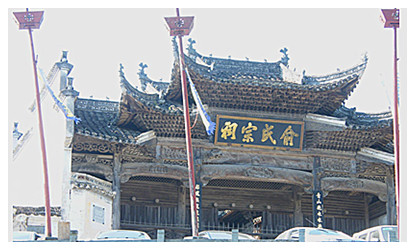Wangkou Ancient Village
History of Wangkou Villlage
Wangkou Ancient Village was first built in the Northern Song Dynasty (960-1127). Taking advantage of the location, during the Ming and Qing Dynasties (1368-1911), this village was an important center of collecting and distributing center in ancient Huizhou and Raozhou. In ancient times, the scale of business activities in Wangkou Village was impressive. There were thousands of merchant ships bobbin at the wharf, lots of stores located on both sides of the street.
What to see?
 Nowadays, this village still maintains many traditional ancient buildings. So it can be regarded as a concentration of elegance and beauty. When tourists visit the village, they will feel an antique flavor and comfortable atmosphere there. Besides, there are lots of well-preserved ancient ancestral halls, merchants’ residences and bookstores with typical architectural style of Ming and Qing Dynasties. Many attractive scenic spots, such as Ancient Street, Yijing Hall, Maode Hall and Yu’s Ancestral Hall have become the essential parts of this village.
Nowadays, this village still maintains many traditional ancient buildings. So it can be regarded as a concentration of elegance and beauty. When tourists visit the village, they will feel an antique flavor and comfortable atmosphere there. Besides, there are lots of well-preserved ancient ancestral halls, merchants’ residences and bookstores with typical architectural style of Ming and Qing Dynasties. Many attractive scenic spots, such as Ancient Street, Yijing Hall, Maode Hall and Yu’s Ancestral Hall have become the essential parts of this village.
 Yijing Hall, built in the Qing Dynasty, covers 150 square meters. Yu Nianzeng, the owner of the hall, is known for his official incorruptible moral behavior. The implied meaning of the name of this building reminds descendants that they should teach the coming generations to work hard and learn abundant knowledge.
Yijing Hall, built in the Qing Dynasty, covers 150 square meters. Yu Nianzeng, the owner of the hall, is known for his official incorruptible moral behavior. The implied meaning of the name of this building reminds descendants that they should teach the coming generations to work hard and learn abundant knowledge. Yu’s Ancestral Hall is one of the most famous ancient buildings in this village. In ancient times, this hall was a formal place to worship the ancestors of the Yu Family. It was built by a civil official named Yu Yinglun. First built in the Qing Dynasty (1644-1911), this building covers 1,334 square yards (1,116 square meters). With a height of 10 meters, a width of 15.6 meters and a length of 42.6 meters, Yu’s Ancestral Hall features exquisite wood carvings and abundant cultural relics. There are three courtyards along the central axis. The front courtyard is a wooden archway whose roof is covered with grey titles. The facade of this archway was engraved with Chinese traditional patterns of dragons and phoenixes. The central courtyard includes three main reception rooms. On both sides of the central courtyard, there is a small and exquisite garden with many kinds of plants and flowers. Hence, it is cited as “Palace of Art” and “Treasure House of Wood Carvings”.
Yu’s Ancestral Hall is one of the most famous ancient buildings in this village. In ancient times, this hall was a formal place to worship the ancestors of the Yu Family. It was built by a civil official named Yu Yinglun. First built in the Qing Dynasty (1644-1911), this building covers 1,334 square yards (1,116 square meters). With a height of 10 meters, a width of 15.6 meters and a length of 42.6 meters, Yu’s Ancestral Hall features exquisite wood carvings and abundant cultural relics. There are three courtyards along the central axis. The front courtyard is a wooden archway whose roof is covered with grey titles. The facade of this archway was engraved with Chinese traditional patterns of dragons and phoenixes. The central courtyard includes three main reception rooms. On both sides of the central courtyard, there is a small and exquisite garden with many kinds of plants and flowers. Hence, it is cited as “Palace of Art” and “Treasure House of Wood Carvings”.
Travel Tips
Add: Wangkou Village, Jiangwan Town, Wuyuan County, Shangrao City,Jiangxi Province
Entrance Fees: CNY 105
Opening Hours: 08:00 -18:00 (March to November) , 8:00 - 17:30 (December to February)







 Ask Questions ?
Ask Questions ?